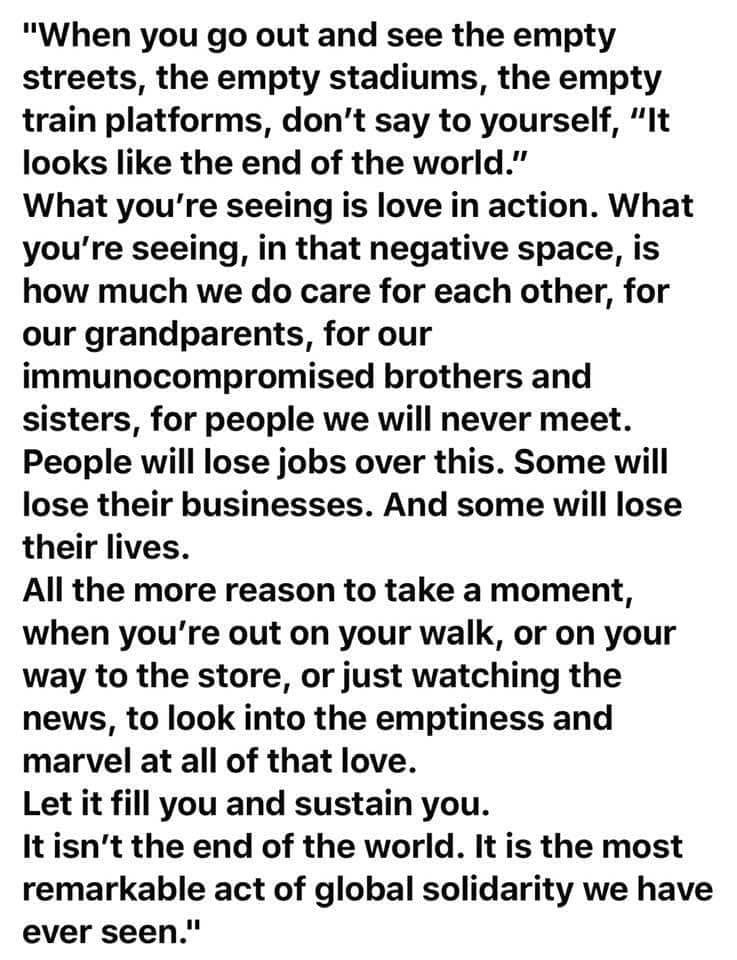This is a great read written by a guy with a very sane viewpoint!
America’s Corona Tsar, Anthony Fauci, Finally Admits COVID-19 Mortality Rate Similar to Flu at 0.1%
In an editorial published in The New England Journal of Medicine (https://www.nejm.org/doi/full/10.1056/NEJMe2002387), several doctors including Anthony Fauci indicate that the case fatality rate of COVID-19 virus may be similar to those seen in a severe seasonal influenza.
(Tom: One could very successfully argue that life is action and death is motionlessness. Two of the most active and alive people I know are my son’s two year old daughter and my daughter’s five year old son. As we age we can less easily move ourselves or tolerate motion in others. And then we die. So the curve of action closely aligns the the curve of life.
Currently we have been scared into physical distancing and inactivity (societal death) by false data – initial reports of a virus severity 50 times worse than it actually is.
Now that this has been exposed as a result of incorrect modeling, let’s call off the disastrous cautions that seemed appropriate and necessary at the time and get back to life! #BackToLife)
Let’s get this show back on the road!
Email your state and federal MP and tell them we want to get back to living!
Now that this has been exposed as a result of incorrect modeling, let’s call off the disastrous cations that seemed appropriate and necessary at the time and get back to life! #BackToLife)
45 places you can download tens of thousands books, plays and other literary texts completely legally for free

In an increasingly digital world, literature is evolving. Sales of e-readers continue to rise, yet the cost of digital books and texts has not necessarily decreased to the extent to which many initially predicted. With authors’ incomes collapsing to near “abject” levels, and with public libraries under threat from swingeing public spending cuts, we felt honour bound to provide our fine readers with some valuable resources that could help save valuable money.
While we of course advocate supporting your local independent book store – and independent publishing houses – and would urge you to purchase copies of your books where you can afford to, below you can find a collection of 45 websites where you can download tens of thousands of books, plays and texts for free. Oh, and these sites are also all completely legal, of course!
In Search Of Truth
I believe Edgar Allan Poe said it well: “Believe nothing you hear, and only one half that you see.”
https://www.goodreads.com/quotes/252780-believe-nothing-you-hear-and-only-one-half-that-you
And it applies to the US and Oz media probably almost as much as it does in China.
The trouble with fully applying Edgar’s advice is that we cannot live long enough in one lifetime to learn from others’ experience all we need to know. The trick is to pick the right people to listen to.
The main stram media are not it, for sure. They are handed their stories to conform to the set agenda and anything not of that agenda is buried.
Voltaire said “To learn who rules over you, simply find out who you are not allowed to criticize.” Well it would appear we are ruled by drug companies as medical professionals are not allowed to criticize their products!
The corollary to that is, “To find out who rules you, find who or what opposes what you are not allowed to promote.”
The recent suppression and invalidation of Vitamin C as a valid therapy for viral infections, despite lots of evidence of their efficacy in so doing, again points the finger at the drug companies. They would make no money from drugs and vaccines if people knew they could cure themselves sith sunshine and vitamin C.
Desiderata
“Go placidly amid the noise and the haste, and remember what peace there may be in silence. As far as possible without surrender, be on good terms with all persons. Speak your truth quietly and clearly, and listen to others, even the dull and ignorant; they too have their story. Be yourself. Especially do not feign affection. Neither be cynical about love – for in the face of all aridity and disenchantment it is perennial as the grass. Take kindly the counsel of the years, gracefully surrendering the things of youth. Nurture strength of spirit to shield you from misfortune. But do not distress yourself with imaginings. Many fears are born of fatigue and loneliness. Beyond a wholesome discipline, be gentle with yourself. You are a child of the universe no less than the trees and the stars; you have a right to be here. And whether or not it is clear to you, no doubt the universe is unfolding as it should. Therefore be at peace with God, whatever you conceive Him to be, and whatever your labours and aspirations, in the noisy confusion of life keep peace with your soul. With all its sham, drudgery and broken dreams, it is still a beautiful world.”
― Max Ehrmann, Desiderata: A Poem for a Way of Life
The Danger of the Single Story

The media are very good at creating single stories. Think back to all the Black PR about Afghanistan prior to the US going to war there, to Syria, to Iraq. Heck, the recent single story about Coronavirus and the one playing out before that about Iran.
Beware the single story. It can shape unrealistic viewpoints.
A Hug

The average length of a hug between two people is 3 seconds. But the researchers have discovered something fantastic. When a hug lasts 20 seconds, there is a therapeutic effect on the body and mind. The reason is that a sincere embrace produces a hormone called “oxytocin”, also known as the love hormone. This substance has many benefits in our physical and mental health, helps us, among other things, to relax, to feel safe and calm our fears and anxiety. This wonderful tranquilizer is offered free of charge every time we have a person in our arms, who cradled a child, who cherish a dog or a cat, that we are dancing with our partner, the closer we get to someone or simply hold the Shoulders of a friend.
A famous quote by psychotherapist Virginia Satir goes, “We need 4 hugs a day for survival. We need 8 hugs a day for maintenance. We need 12 hugs a day for growth.” Whether those exact numbers have been scientifically proven remains to be seen, but there is a great deal of scientific evidence related to the importance of hugs and physical contact. Here are some reasons why we should hug::
1. STIMULATES OXYTOCIN
Oxytocin is a neurotransmitter that acts on the limbic system, the brain’s emotional centre, promoting feelings of contentment, reducing anxiety and stress, and even making mammals monogamous. It is the hormone responsible for us all being here today. You see this little gem is released during childbirth, making our mothers forget about all of the excruciating pain they endured expelling us from their bodies and making them want to still love and spend time with us. New research from the University of California suggests that it has a similarly civilising effect on human males, making them more affectionate and better at forming relationships and social bonding. And it dramatically increased the libido and sexual performance of test subjects. When we hug someone, oxytocin is released into our bodies by our pituitary gland, lowering both our heart rates and our cortisol levels. Cortisol is the hormone responsible for stress, high blood pressure, and heart disease.
2. CULTIVATES PATIENCE
Connections are fostered when people take the time to appreciate and acknowledge one another. A hug is one of the easiest ways to show appreciation and acknowledgement of another person. The world is a busy, hustle-bustle place and we’re constantly rushing to the next task. By slowing down and taking a moment to offer sincere hugs throughout the day, we’re benefiting ourselves, others, and cultivating better patience within ourselves.
3. PREVENTS DISEASE
Affection also has a direct response on the reduction of stress which prevents many diseases. The Touch Research Institute at the University of Miami School of Medicine says it has carried out more than 100 studies into touch and found evidence of significant effects, including faster growth in premature babies, reduced pain, decreased autoimmune disease symptoms, lowered glucose levels in children with diabetes, and improved immune systems in people with cancer.
4. STIMULATES THYMUS GLAND
Hugs strengthen the immune system. The gentle pressure on the sternum and the emotional charge this creates activates the Solar Plexus Chakra. This stimulates the thymus gland, which regulates and balances the body’s production of white blood cells, which keep you healthy and disease free.
5. COMMUNICATION WITHOUT SAYING A WORD
Almost 70 percent of communication is nonverbal. The interpretation of body language can be based on a single gesture and hugging is an excellent method of expressing yourself nonverbally to another human being or animal. Not only can they feel the love and care in your embrace, but they can actually be receptive enough to pay it forward to others based on your initiative alone.
6. SELF-ESTEEM
Hugging boosts self-esteem, especially in children. The tactile sense is all-important in infants. A baby recognizes its parents initially by touch. From the time we’re born our family’s touch shows us that we’re loved and special. The associations of self-worth and tactile sensations from our early years are still imbedded in our nervous system as adults. The cuddles we received from our Mom and Dad while growing up remain imprinted at a cellular level, and hugs remind us at a somatic level of that. Hugs, therefore, connect us to our ability to self love.
7. STIMULATES DOPAMINE
Everything everyone does involves protecting and triggering dopamine flow. Low dopamine levels play a role in the neurodegenerative disease Parkinson’s as well as mood disorders such as depression. Dopamine is responsible for giving us that feel-good feeling, and it’s also responsible for motivation! Hugs stimulate brains to release dopamine, the pleasure hormone. Dopamine sensors are the areas that many stimulating drugs such as cocaine and methamphetamine target. The presence of a certain kinds of dopamine receptors are also associated with sensation-seeking.
8. STIMULATES SEROTONIN
Reaching out and hugging releases endorphins and serotonin into the blood vessels and the released endorphins and serotonin cause pleasure and negate pain and sadness and decrease the chances of getting heart problems, helps fight excess weight and prolongs life. Even the cuddling of pets has a soothing effect that reduces the stress levels. Hugging for an extended time lifts one’s serotonin levels, elevating mood and creating happiness.
9. PARASYMPATHETIC BALANCE
Hugs balance out the nervous system. The skin contains a network of tiny, egg-shaped pressure centres called Pacinian corpuscles that can sense touch and which are in contact with the brain through the vagus nerve. The galvanic skin response of someone receiving and giving a hug shows a change in skin conductance. The effect in moisture and electricity in the skin suggests a more balanced state in the nervous system – parasympathetic.
Embrace, embrace with your heart.
First Three Doctors

The three women pictured in this incredible photograph from 1885 — Anandibai Joshi of India, Keiko Okami of Japan, and Sabat Islambouli of Syria — each became the first licensed female doctors in their respective countries. The three were students at the Women’s Medical College of Pennsylvania; one of the only places in the world at the time where women could study medicine.
As Mallika Rao writes in HuffPost, “If the timing doesn’t seem quite right, that’s understandable. In 1885, women in the U.S. still couldn’t vote, nor were they encouraged to learn very much. Popular wisdom decreed that studying was a threat to motherhood.” Given this, how did three women from around the world end up studying there to become doctors? The credit, according to Christopher Woolf of PRI’s The World, goes to the Quakers who “believed in women’s rights enough to set up the WMCP way back in 1850 in Germantown.”
Woolf added, “It was the first women’s medical college in the world, and immediately began attracting foreign students unable to study medicine in their home countries. First they came from elsewhere in North America and Europe, and then from further afield. Women, like Joshi in India and Keiko Okami in Japan, heard about WMCP, and defied expectations of society and family to travel independently to America to apply, then figure out how to pay for their tuition and board… . Besides the international students, it also produced the nation’s first Native American woman doctor, Susan La Flesche, while African Americans were often students as well. Some of whom, like Eliza Grier, were former slaves.”
To introduce children to more pioneering female doctors, we recommend the picture books: “Who Says Women Can’t Be Doctors? The Story of Elizabeth Blackwell” for ages 4 to 8 (https://www.amightygirl.com/who-says-women-can-t-be-doctors), “Dr. Jo: How Sara Josephine Baker Saved the Lives of America’s Children” for ages 5 to 9 (https://www.amightygirl.com/dr-jo), and “The Doctor with an Eye for Eyes: The Story of Dr. Patricia Bath” for ages 5 to 9 (https://www.amightygirl.com/the-doctor-with-an-eye-for-eyes)
For a fascinating book for adults about America’s first Native American doctor, Susan La Flesche, we highly recommend “A Warrior of the People” at http://amzn.to/2zdzcDf
For more books to show kids that science is for everyone regardless of gender, check out our blog post, “60 Books to Inspire Science-Loving Mighty Girls,” at https://www.amightygirl.com/blog?p=13914
And, to encourage your Mighty Girl to make her mark on the world as a doctor or scientist, you can find toys and kits to foster her interest in our blog post, “Top 60 Science Toys for Mighty Girls,” at https://www.amightygirl.com/blog?p=10528
Going Where?

Bears no relationship whatever to our current situation.
Love In Action

Thank you for caring!
